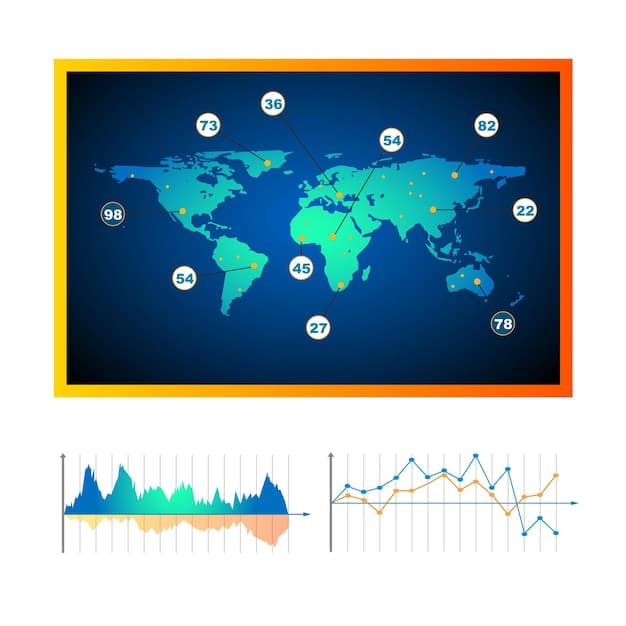Data Analytics and Shaping Social Commentary: Impact on Public Opinion

Data analytics is increasingly shaping social commentary and public opinion by providing insights into trends, sentiments, and behaviors, which in turn influences narratives and discussions in society.
The rise of data analytics has fundamentally altered the landscape of social commentary and public opinion. By providing unprecedented insights into human behavior, preferences, and societal trends, these tools now significantly shape how we understand and discuss the world around us.
How data analytics transforms social commentary
Data analytics has become a powerful tool for understanding societal trends. By analyzing vast amounts of information, patterns emerge that provide insights into public sentiment and behavior. This shapes how social commentary is formed and disseminated.
The transformation is driven by the ability to sift through immense datasets, uncovering correlations that would be impossible to detect manually. As a result, social commentators and journalists are increasingly relying on data-driven insights to inform their narratives and analyses.
The role of data in modern journalism
Journalists can now use data analytics to identify trends, verify facts, and create more informed stories. This leads to a higher level of credibility and relevance in their reporting.
Data-driven storytelling
Social commentators are also leveraging data to craft compelling narratives that resonate with audiences. By presenting information in a visually appealing and easily digestible format, they can influence public opinion and spark meaningful conversations.

- Enhanced Accuracy: Data analytics provides factual grounding, reducing reliance on anecdotal evidence.
- Improved Relevance: Insights derived from data ensure that social commentary addresses current and pressing issues.
- Increased Engagement: Visualizations and data-driven stories capture public attention.
In conclusion, data analytics offers a more robust and nuanced understanding of social trends. By providing evidence-based insights, it empowers social commentators to create more informed, accurate, and impactful content. This transformation is changing the nature of social discourse, making it more data-driven and evidence-based.
Analyzing public opinion through data
Public opinion, once gauged through traditional surveys and polls, is now often measured through sophisticated data analytics. Analyzing everything from social media posts to online search queries offers a deeper understanding of what people think and feel.
This data-driven approach can reveal nuanced trends and sentiments that traditional methods might miss. As a result, policymakers, businesses, and social commentators are paying close attention to these analytics to understand and influence public perception.
Tracking sentiment on social media
Social media platforms generate vast amounts of data, including posts, comments, and shares. By analyzing the sentiment expressed in these interactions, it’s possible to gauge public opinion on various issues.
The use of search query analysis
Search queries provide valuable insights into what people are interested in and concerned about. Analyzing these queries can reveal emerging trends and shifts in public opinion.
Data analytics provides a more dynamic and comprehensive view of public sentiment.
- Real-time feedback: Data analytics allows for immediate assessment of public reactions to events or policies.
- Granular insights: It provides a more detailed understanding of public opinion, beyond simple approval or disapproval ratings.
- Predictive Capabilities: By identifying trends, data analytics can help forecast future shifts in public sentiment.
In closing, analyzing public opinion through data provides valuable insights that can be used to inform decision-making and shape public discourse. It allows for a more nuanced and accurate understanding of societal attitudes.
Ethical considerations in data-driven social commentary
The use of data analytics in social commentary is not without its challenges. Ethical considerations, such as privacy, bias, and transparency, must be carefully addressed to ensure responsible and fair use of data.
Failing to address these ethical concerns can lead to misinformation, manipulation, and erosion of public trust. Therefore, it’s essential to establish guidelines and best practices for data-driven social commentary.

Addressing data privacy concerns
Data privacy is paramount. Social commentators must ensure that they are not collecting or using personal data in a way that violates individuals’ privacy rights.
Avoiding bias in data analysis
Algorithms and datasets can reflect the biases of their creators or the data they are trained on. Social commentators need to be aware of these biases and take steps to mitigate them.
- Data validation: Ensure the accuracy and reliability of the data being used.
- Algorithmic transparency: Understand how algorithms work and what biases they might contain.
- Fairness metrics: Implement metrics to evaluate and address bias in data analysis.
In summary, addressing ethical considerations is crucial for maintaining the integrity and credibility of data-driven social commentary. By prioritizing privacy, mitigating bias, and promoting transparency, social commentators can ensure that their work benefits society as a whole.
The impact of data analytics on political discourse
Data analytics is reshaping political discourse by providing candidates and parties with detailed insights into voter preferences, behaviors, and sentiments. This enables them to tailor their messages and strategies for maximum impact.
However, the use of data analytics in politics also raises concerns about manipulation, misinformation, and the erosion of democratic processes. Therefore, it’s essential to scrutinize how data is being used in the political arena.
Microtargeting and political campaigns
Political campaigns use microtargeting to deliver personalized messages to individual voters based on their demographics, interests, and political beliefs. This can be highly effective in influencing voter behavior.
Combating misinformation with data
Data analytics can be used to identify and debunk misinformation campaigns. By analyzing the spread of false information, fact-checkers can quickly respond and counteract its effects.
This has some positive impacts in political discourse.
- Informed Campaigns: Data helps in understanding voter needs and preferences.
- Targeted Messaging: Personalized communication can increase voter engagement.
- Combating Disinformation: Analytics can help identify and counteract the spread of false information.
In conclusion, data analytics plays a significant role in shaping political discourse. While it offers valuable tools for campaigns and policymakers, it’s essential to address the ethical considerations and potential risks associated with its use. By promoting transparency and accountability, we can ensure that data analytics contributes to a more informed and democratic political process.
The future of social commentary in a data-driven world
As data analytics continues to evolve, its impact on social commentary will only deepen. The future of social commentary will be characterized by more data-driven insights, personalized narratives, and real-time engagement.
However, it’s crucial to address the ethical considerations and potential risks associated with the use of data analytics. This includes protecting privacy, mitigating bias, and ensuring transparency.
Emerging trends in data analytics
The development of new analytics tools and techniques will provide even deeper insights into human behavior and societal trends. This includes advancements in natural language processing, machine learning, and artificial intelligence.
The role of AI in social commentary
AI will play an increasing role in analyzing data, generating insights, and creating compelling narratives. However, it’s essential to ensure that AI systems are used responsibly and ethically.
The future seems bright.
- Enhanced Insights: New analytics tools will provide even deeper insights into social trends.
- Personalized Narratives: Data will enable more targeted and relevant social commentary.
- Real-Time Engagement: Social commentators can respond more quickly to emerging issues and public sentiment.
In closing, the future of social commentary in a data-driven world is full of possibilities. By harnessing the power of data analytics responsibly and ethically, we can create a more informed, engaged, and equitable society.
Case studies: Data analytics in action
Examining real-world examples of how data analytics shapes social commentary and public opinion provides valuable insights into its impact. These case studies illustrate the potential benefits and risks associated with its use.
By analyzing these examples, we can learn from both the successes and failures of data-driven social commentary. This informs best practices and helps ensure responsible use of data analytics.
Case study 1: Analyzing sentiment during a political debate
Data analytics was used to track public sentiment in real-time during a political debate. This provided valuable insights into how different arguments and statements resonated with voters.
Case study 2: Identifying fake news on social media
Data analytics was used to identify and debunk fake news stories on social media. By analyzing patterns in the spread of misinformation, fact-checkers were able to quickly respond and counteract its effects.
Some interesting data can be gathered.
- Real-Time Insights: Data analytics provided immediate feedback on voter reactions during a political debate.
- Combating Misinformation: Analytics helped to identify and debunk fake news stories.
- Improved Understanding: Case studies offer practical examples of how data analytics can be used to shape social commentary.
In summary, these case studies demonstrate the real-world impact of data analytics on social commentary and public opinion. By learning from these examples, we can develop best practices and ensure responsible use of data analytics in the future.
| Key Point | Brief Description |
|---|---|
| 📊 Data & Journalism | Enhances accuracy and relevance in reporting. |
| 🗣️ Sentiment Analysis | Tracks public reactions on social media in real-time. |
| 🛡️ Ethical Concerns | Addresses bias, privacy, and transparency. |
| 🎯 Microtargeting | Personalizes political messaging for engagement. |
Frequently Asked Questions
Data analytics provides factual grounding, enhances relevance, and increases engagement in social commentary by providing evidence-based insights.
Ethical concerns include data privacy, algorithmic bias, and the transparency of data sources, all of which must be carefully addressed to ensure fair use.
Data analytics enables microtargeting, helps identify voter preferences, and can combat misinformation, thereby playing a pivotal role in campaign strategies.
Emerging trends include the use of AI for data analysis, personalized narratives, and real-time engagement to respond quickly to societal trends and issues.
Yes, data analytics can identify patterns in the spread of false information, allowing fact-checkers to respond quickly and counteract its effects on public opinion.
Conclusion
In conclusion, the increasing use of data analytics is significantly shaping social commentary and public opinion by providing evidence-based insights, enabling personalized narratives, and facilitating real-time engagement. However, it is crucial to address the ethical considerations and potential risks associated with its use to ensure responsible and fair implementation in social and political contexts.





